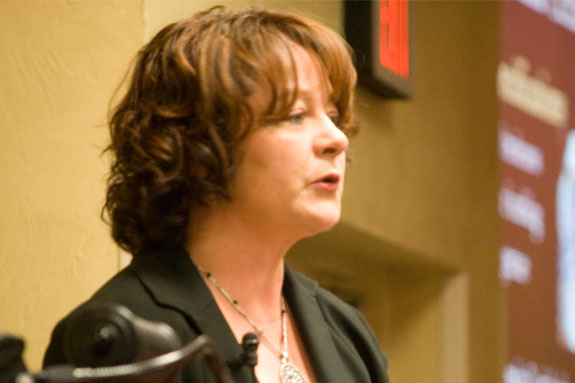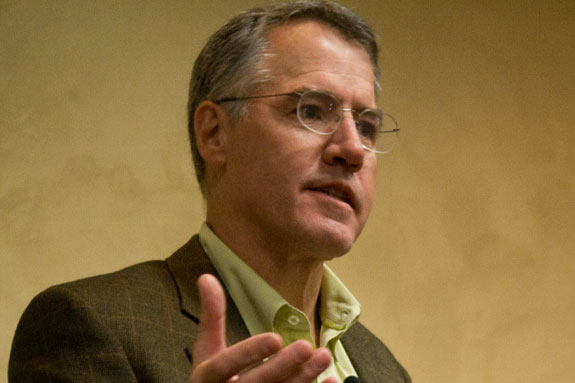Conference presentations gave participants information on beef product marketing, team management, the world’s rapidly changing media, the latest in high nutrition feed and the domestic/global beef markets.
The registered attendance set a new high mark for the annual National Angus Conference, which was held off last year because of the World Angus Event in Canada. This year Angus producers from 33 states and three foreign countries made the journey to Bozeman and Yellowstone Country to observe Angus production with several Montana producers.
Tour stops included KG Ranch of Three Forks, Hyline Angus Ranch outside Bozeman, Armstrong Angus Ranch of Cardwell, Wheeler Mountain Ranch and Split Diamond Ranch in Whitehall, Van Dyke Angus Ranch in Manhattan, the Montana State University Bioscience Lab building, Leachman Angus Ranch in Toston and Sitz Angus Ranch in Harrison.
To see a photo gallery of the NAC Tour, visit the Progressive Cattleman Facebook page.
Here are some summaries of conference speakers:
Tracey Erickson
Certified Angus Beef Vice President Tracey Erickson informed participants that the economy hasn’t abandoned all high-quality trends in retail. Erickson, who spearheads the consumer marketing push for the CAB brand, said today’s consumers are spending on “feel good” products at home, including ice cream and beef, because “they still have a sire to treat themselves.”

“They may not go out,” Erickson said. “But there’s an interesting psyche in that they’re still buying quality beef.”
The message of higher niche products, such as Certified Angus Beef, is reinforced by studies showing retail growth between 10 and 20 percent, and even as high as 40 percent, on CAB products when chains continued featuring those products in key displays.
“Being in that premium feel-good category has given us some staying power in spite of economic conditions,” Erickson said.
To maximize the brand among consumers, CAB has specifically targeted the an audience of married women ages 34 to 54, and also men in the same categories, largely because of the buying initiative in families.
“We have to make sure the person that has the power of decision making knows the value the product brings,” she said, explaining that the mandate is to bridge the gap from producers to consumers.
Part of that effort includes more education on the production of beef, which is critical since the average married female buyer in the target age has been removed from agriculture. Market research shows today’s average consumers are usually two to three generations removed from family farms. Yet Erickson said “the perspective of those who do not have an ag connection is huge to Certified Angus Beef.”
“They don’t know a lot about beef, but the consumer is not stupid.”
Erickson suggests that producers immerse themselves in any opportunity to showcase products, educate the consumer about high quality meat cuts, as well as the success story of traditional ranching. That information needs to come from working cattle producers – using terminology that audiences relate to, such as “sustainable,” “humane” and “cattlemen.”
“If we don’t connect to the consumers, the misperceptions will spread,” she said.
Chef John Doherty
It was during his early days at the legendary Waldorf Astoria hotel in New York City that young John Doherty recognized a serious flaw with the restaurant.
The menu was missing a key ingredient – fresh food.

One of the ritziest hotels in the world was serving clientele stale frozen beef, flaked mashed potato mix and bagged vegetables, and the difference was usually noticeable on the plate.
Doherty, who started cooking at age 15 and is a Culinary Institute of America graduate, told conference attendees of his path to the highest circles of the hospitality industry.
It wasn’t easy. The biggest challenges were changing the resistant and complacent attitude of some Waldorf staff. But the desire for change, Doherty said, is a constant for any professional, be it a chef, a manager, or a rancher. “Quality always works,” he said, “and doing the right thing always works.”
As a result, higher quality products, including Certified Angus Beef and prime cuts of beef, were what helped “change the performance of the Waldorf.”
Relating his restaurant experience to cattle producers, Doherty said the difference between managers and leaders can often be defined as differentiating process versus inspiration. A key part to that is emphasizing praise in the workplace.
“People receive positive feedback, and they want more and start thinking for themselves,” he said. “If you offend them, or shame them, they put up a wall.”
In his travels to cattle producers, Doherty said he was shocked how much he had to learn about the ranching industry. “I had no idea it took so much land for cattle to roam and eat.”
He said the drop in supply is hitting the industry, largely for the lack of USDA prime beef, which costs so much now that it was even dropped from his menu. “We’ve got to be able to get it off the plate.”
Charlie Powell
If another food crisis hits the beef industry, cattle producers will be responding to media that are more numerous, larger and more immediate in response than what was seen during the bovine spongiform encephalopathy (BSE) crisis of 2003.

Charlie Powell, the senior public information officer for Washington State University’s vet medicine college, was on the front lines when the mad-cow crisis unfolded at the Canada-Washington border. Since then, Powell said cattle producers are even more at risk if they don’t prepare for crisis communication.
The worst thing producers can do with today’s social media – including Facebook, Twitter, RSS feeds, blogs, YouTube clips, and other peer-to-peer communication – is dismiss them.
“Today, anyone with access to electricity and the Internet can potentially reach more people
faster than any news organization in history,” Powell outlined in his demonstration. “There are few if any checks or balances on any aspect of these communications.”
As an example, Powell said it took just nine months for Facebook to reach 12 million users, far faster than any other medium in history. Today, if Facebook were a country, it would be the third largest in the world, behind China and India.
With such a shifting dynamic at play for global information, Powell said food producers must be proactive in their ability to respond and control their message. If they don’t, others will do it for them.
Noting the power of imagery, with YouTube clips showcasing some animal cruelty at some livestock operations, Powell said that trend is bound to continue. But producers should arm themselves, by training and monitoring employees – and even recording their own operations if necessary.
“Employees will change behavior if they know they’re on camera,” Powell said. Having video also allows a producer to compare that with hidden video taken on the premises.
Randy Blach
The CEO for Cattle-Fax gave a presentation on domestic supply, global demand, per-capita consumption, and productivity rates – with a picture as consistent as it is complete. The supply of U.S. beef is dropping, while demand for the product is continuing to climb.

Starting in 2007, the production cycle has been defined more by demand than supply. Three years later there still isn’t enough beef. That’s the opportunity facing producers, Blach said, especially since he predicts “with a good degree of certainty we’re going to have smaller supply over the next three years.”
Demand is driven up due to population growth, but mostly because U.S. beef is unparalleled in its quality.
“I think there gets to be a lot of confusion as to who is the No. 1 beef producer around the globe,” Blach said. “It’s you, not Brazil. Because the lion’s share of our animals are high quality fed beef with a harvest weight 1,250 to 1400 pounds. They’re not grass fed animals.”
Premium programs such as the Certified Angus Beef brand are driving the demand for U.S. beef even higher, which is even more impressive considering the national beef herd decline that’s gradually occurred since 1975.
When talking to retailers, Blach said he commonly hears debate about the cut weights being too high.
“My response is, ‘Deal with it.’ Because it’s this simple, the market still pays us more for weight than any other thing in the system.”
That focus is making producers even more efficient, he said, considering how cut weights are compensating for the decline in the herd size.
“The increase in the weights alone has offset the need for basically 5 million cows. Does that sound like an industry that is getting a bit more efficient? Absolutely.”
Blach sounded words of caution on the proposed USDA Grain Inspection, Packers and Stockyards Inspection rule changes that would restrict packer ownership terms, and limit the exclusive arrangements between packers and dealers.
“A lot of these premium programs that we’ve built, that you’ve invested your genetics in over the course of the last 20 years, I think they’re at risk,” Blach said. “Because who’s going to go out here and stick their neck out and have the potential to be sued.”
Rather than focusing on those market arrangements, Blach said the administration would be better serving producers by focusing on markets that still haven’t opened up fully to U.S. beef exports. ![]()
For more materials on the National Angus Conference and Tour visit www.nationalangusconference.com








